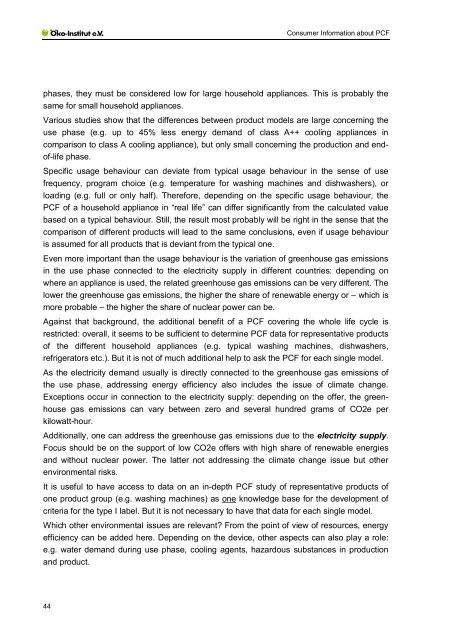Requirements on Consumer Information about Product ... - ANEC
Requirements on Consumer Information about Product ... - ANEC
Requirements on Consumer Information about Product ... - ANEC
You also want an ePaper? Increase the reach of your titles
YUMPU automatically turns print PDFs into web optimized ePapers that Google loves.
C<strong>on</strong>sumer Informati<strong>on</strong> <strong>about</strong> PCF<br />
phases, they must be c<strong>on</strong>sidered low for large household appliances. This is probably the<br />
same for small household appliances.<br />
Various studies show that the differences between product models are large c<strong>on</strong>cerning the<br />
use phase (e.g. up to 45% less energy demand of class A++ cooling appliances in<br />
comparis<strong>on</strong> to class A cooling appliance), but <strong>on</strong>ly small c<strong>on</strong>cerning the producti<strong>on</strong> and endof-life<br />
phase.<br />
Specific usage behaviour can deviate from typical usage behaviour in the sense of use<br />
frequency, program choice (e.g. temperature for washing machines and dishwashers), or<br />
loading (e.g. full or <strong>on</strong>ly half). Therefore, depending <strong>on</strong> the specific usage behaviour, the<br />
PCF of a household appliance in “real life” can differ significantly from the calculated value<br />
based <strong>on</strong> a typical behaviour. Still, the result most probably will be right in the sense that the<br />
comparis<strong>on</strong> of different products will lead to the same c<strong>on</strong>clusi<strong>on</strong>s, even if usage behaviour<br />
is assumed for all products that is deviant from the typical <strong>on</strong>e.<br />
Even more important than the usage behaviour is the variati<strong>on</strong> of greenhouse gas emissi<strong>on</strong>s<br />
in the use phase c<strong>on</strong>nected to the electricity supply in different countries: depending <strong>on</strong><br />
where an appliance is used, the related greenhouse gas emissi<strong>on</strong>s can be very different. The<br />
lower the greenhouse gas emissi<strong>on</strong>s, the higher the share of renewable energy or – which is<br />
more probable – the higher the share of nuclear power can be.<br />
Against that background, the additi<strong>on</strong>al benefit of a PCF covering the whole life cycle is<br />
restricted: overall, it seems to be sufficient to determine PCF data for representative products<br />
of the different household appliances (e.g. typical washing machines, dishwashers,<br />
refrigerators etc.). But it is not of much additi<strong>on</strong>al help to ask the PCF for each single model.<br />
As the electricity demand usually is directly c<strong>on</strong>nected to the greenhouse gas emissi<strong>on</strong>s of<br />
the use phase, addressing energy efficiency also includes the issue of climate change.<br />
Excepti<strong>on</strong>s occur in c<strong>on</strong>necti<strong>on</strong> to the electricity supply: depending <strong>on</strong> the offer, the greenhouse<br />
gas emissi<strong>on</strong>s can vary between zero and several hundred grams of CO2e per<br />
kilowatt-hour.<br />
Additi<strong>on</strong>ally, <strong>on</strong>e can address the greenhouse gas emissi<strong>on</strong>s due to the electricity supply.<br />
Focus should be <strong>on</strong> the support of low CO2e offers with high share of renewable energies<br />
and without nuclear power. The latter not addressing the climate change issue but other<br />
envir<strong>on</strong>mental risks.<br />
It is useful to have access to data <strong>on</strong> an in-depth PCF study of representative products of<br />
<strong>on</strong>e product group (e.g. washing machines) as <strong>on</strong>e knowledge base for the development of<br />
criteria for the type I label. But it is not necessary to have that data for each single model.<br />
Which other envir<strong>on</strong>mental issues are relevant? From the point of view of resources, energy<br />
efficiency can be added here. Depending <strong>on</strong> the device, other aspects can also play a role:<br />
e.g. water demand during use phase, cooling agents, hazardous substances in producti<strong>on</strong><br />
and product.<br />
44
















